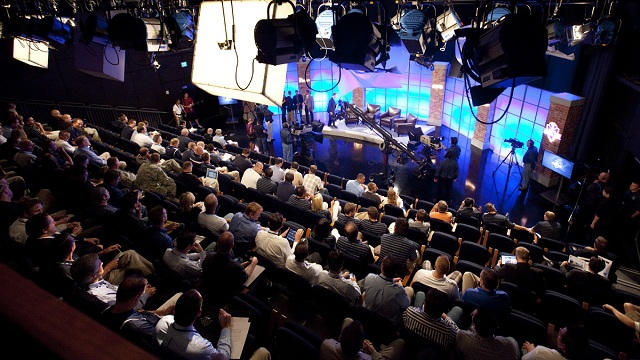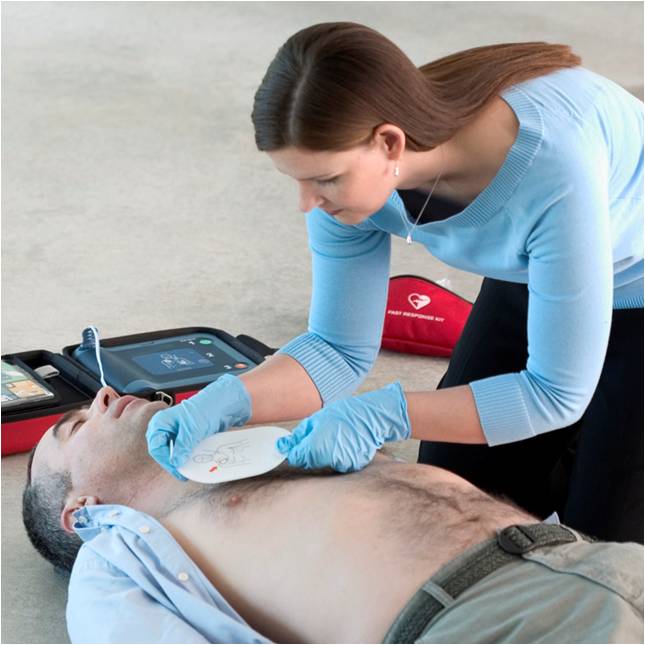Broadcast studio facilities are technological wonders that produce some of our most enjoyable entertainment within its four walls. Behind the cameras and glamour, though, is a windowless, soundproof, power consuming hog that probably won’t win any energy efficiency or daylighting awards.
When selecting a building to retrofit for a studio facility, it’s more than just large space and tall ceilings to suit the needs for live television. Broadcast facilities face many idiosyncrasies and spoilers that challenge real estate brokers, and is magnified especially in horizontally and vertically challenged locations such as New York City.
TV studios are sized for different applications. An “Insert Stage” is often a small studio useful for one or two-camera “talking heads”, satellite media tours or product shots. Its average size is 1,500 square feet +/- 1,000 sq ft. Larger stages suitable for audience talk shows average 3,500-15,000 sq ft behemoths and larger. This article focuses on large stages.
Brokers in site selection phase are generally searching for space with the following parameters:
Location, Location, Location – Talk shows often choose stages that are situated in areas where there’s access to high foot traffic, mass transit or easy parking. Talk shows will shoot 2-3 shows per day and must keep a flow of 200+ audience members for each production. Location aides in filling audience seats when attendance might be low. Location may also be a factor in determining the on-screen talent’s decision to choose your stage such as ease of booking guests, commuting to or from airports, or ease of getting around town.
Acoustics – While “Location, Location, Location” is often the rallying cry of most studio executives during site selection, “Audio, Audio, Audio” is the primary concern of most facility engineers during this phase. Sound and acoustics can be the biggest spoiler to any facility’s success and not addressed properly, can be the single studio killer. Sound transmission from existing interior infrastructure and exterior noises must be analyzed for a studio to be successful.
Studios are acoustically constructed to mitigate sounds. Audio engineers check for a building’s acoustical properties, isolation, diffusion and absorption of reflected sound that could compromise audio heard through speakers. Sound and vibration will travel through poorly insulated walls, holes, broken seals and gaskets, windows and air vents. In live television, there are no second chances. Ambient sounds will be picked up by microphones and recorded or broadcast live so not every space will work.
Here are some issues I have encountered that have compromised audio including:
– Selecting a building near an international airport or heliport with the roar of engines and choppers overhead; Choosing a low floor near the rumbling of a subway directly below; Choosing a building with squeaky wood plank floors that amplify footsteps and squeaks from areas outside the studio; Selecting a building next to an industrial location with forklifts dropping pallets and backup warning tones beeping.
Yes, there are ways to minimize or eliminate these issues through construction, but the costs may be burdensome.
Column Free Space with High Ceilings – For the NYC RE brokers, I might as well have written wuh-wah-wuh-wah-wah. Existing expansive column free space with high ceilings is hard to come by here in vertical buildings as compared to other markets where success can be found in horizontal sprawl.
Column free space allows productions to construct large sets, sometimes several on one stage; backstage area, audience risers, and there are no impediments to camera angles. High ceilings allow optimal lighting grid heights which might be at least 20-25′, though many existing buildings have ceilings that limit grid heights at a maximum of 13′. There also needs to be space above the grid for HVAC ducting.
Floors and Ceilings – Squeaky creaky wood floors contribute to ambient noise in television production. Concrete floor and ceiling construction to minimize unwanted sound transmission from above and below is more desirable. Generous floor loads should be capable of supporting audiences and vehicles used in production.
Power – Studios are energy pigs. Power consumption for studio lighting, equipment and HVAC is quite high. Brokers need to assess the studio’s planned needs and inquire what costs will be assessed to bring in additional power to the space.
HVAC – Lighting is hot, audiences generate heat and humidity, control rooms and engineering spaces also generate tremendous heat loads. Studio HVAC systems must be designed to cool down hot stages, as well as address heat generated in audience holding areas, control rooms, engineering and production spaces. Systems also have to be silenced so the whirring of air handlers are not picked up by microphones. This is achieved by installing large ducts so air handlers can be slowed down, lined ducts, bends in the ductwork to tamp down air volume and sound baffles at registers.
Production Space – These spaces can include production office space for long-term talk show clients, video control rooms, audio control rooms, set construction, props, scenic storage, lighting storage and dimmer room, engineering, editing rooms, voice over booths, audience holding area, wardrobe, make-up and hair, showers, green rooms, studio staff office space, graphics design, to name just a few.
Large Freight Elevator – Used to transport sets and vehicles from the ground to the upper stages.
Access to Fiber or Microwave Line of Sight – For facilities to transmit its signal to an earth station or video switching center, the building must have access to video fiber or line of sight from the roof to a microwave facility.
Summary
This is a specialty area that is much more involved than your typical commercial real estate search. Brokers need to be engaged and versed in production to understand the full scope of the facilities needs in order to present space worth considering.
Richard Neuman is a broadcast facilities consultant with owner’s rep firm Relocation Management Solutions. Neuman is former General Manager of NYC’s Times Square Studios and Vice President of Broadcasting, Facilities and Technology at News Broadcast Network.
Discover more from Helping NYC & Long Island Commercial Tenants, Owners, and Developers
Subscribe to get the latest posts sent to your email.






As CE for the former Merrill Lynch Satellite Network, I was involved in the planning, design and execution of a $20M facility in the World Financial Center. At the time, the buildings were just going up, and we actually had a double-height space constructed on the 23rd Fl. with floating floors for the two studios. Your post is excellent, and I can only add that being on-site DAILY is paramount to the finished product! I remember showing up one day and finding a 24 inch pipe running through the ceiling of Studio A. It seems that the contractor needed to re-route a waste pipe and chose our studio as a convenient passageway! I patiently explained that we did not need the sound of a “Babbling brook” (I was being diplomatic), in our studio and after much negotiation, the pipe was re-routed.
I could write a book, but I’ll leave it at that.
Keith Andoos
Love this blog post. It brings back memories of my recording studio client. I loved these people and did all I could to accommodate them. They wanted our location and loved the space. Trouble started when they had a high pitch “g” on all of their recordings. I may be wrong on the exact term but we had to unravel a huge problem. For all of the cost and work involved to soundproof the space, we had a sound nobody could isolate. It turns out a major building pump was touch something along the way through its travels in the building as it as vibrating!! We had sound experts come in and did so much testing to isolate this high pitch. Only the recording equipment could pick it up.
The end result is we had to perform some modifications to the pump. It has to be jacked up and a large base built and special sound deading baffles had to float it above the base in some way to prevent it from vibrating. I think the vibrating was making other pipes rattle causing the noise. Now I do not know if today’s technology would have been able to predict this BEFORE they moved in or not, but back then they were not able to determine this until after the entire job was built out and they starting recording!
Love your contributions Richard and I do see your blogs come through Tumblr and grab them there! Hope it is working for you. I need some testimonials on how it is to blog with us. We want it to be super easy for everyone!
Thanks,
Linda
Hi Linda-
Thanks for the feedback. Yep, you described a perfect example of unanticipated issues.
There’s an endless list of causes to a high pitch digital whine in audio recordings at new facilities. Other causes I’ve encountered include lighting dimmer switches in the audio rooms (low-RFI dimmers should only be used), whistling from air handlers/registers, pipes in building chases, audio cables running parallel to electric – even motion detectors. We recommend hospital grade power and isolated grounds to minimize interference to both audio and video.
It’s pretty amazing that your consultants were able to isolate it to a mechanical pump and add the isolation mounts to correct it.
I agree that it’s hard to tell if it could have been caught in advance. Audio issues are the toughest to overcome.